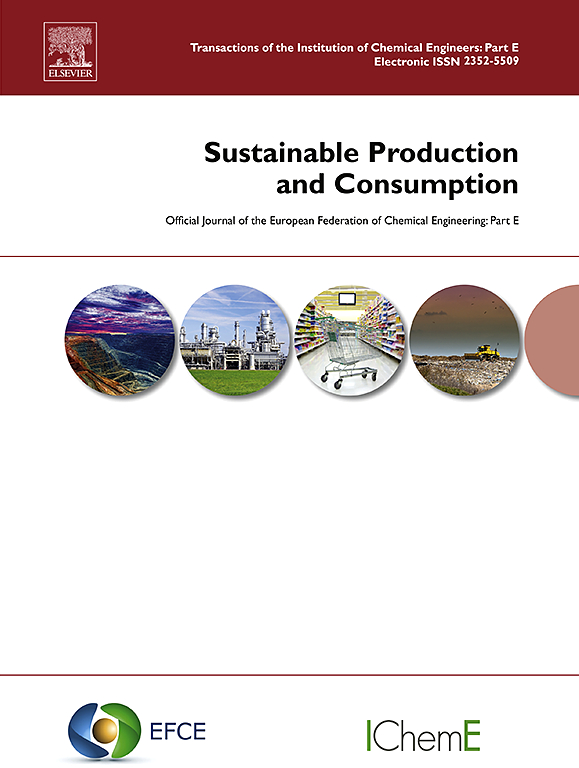利用物料循环度和循环流量指标评价农产品循环度
IF 9.6
1区 环境科学与生态学
Q1 ENVIRONMENTAL STUDIES
引用次数: 0
摘要
加强农业粮食系统的循环,通过减少化肥或农药等投入和食物浪费,提高资源效率,同时降低对环境的影响。然而,对于哪种循环指标最适合这个行业,并没有达成共识。本研究首次联合应用材料循环度指标(MCI)和循环流量指数(CFI)来评估生物制品鸡肉的循环度。选择它们是因为它们具有互补性:MCI提供更广泛的材料效率评估,考虑到产品和废物的回收含量和再循环率,而CFI强调内部再循环和闭环回收。因此,在同一农场内采购鸡饲料和重复使用粪肥可以增加CFI下的循环得分。该研究还首次比较了两种不同保质期和食物浪费百分比的肉类包装系统的循环性:系统A(15天保质期,15%食物浪费)与系统B(6天保质期,47%食物浪费)。结果表明,当将产品寿命纳入其效用因子时,只有MCI捕捉到了食物浪费的显著差异(15% vs 47%)。这凸显了MCI对产品寿命的敏感性。整合碳足迹测量进一步揭示了两个系统之间的显著环境差异,强调需要将循环指标与基于生命周期的指标结合起来,以更好地决策。提出的框架-结合MCI, CFI和生命周期指标-提供了一种更全面的方法来测量生物系统的循环。建议进行进一步的研究,以检验新的案例研究和调整现有的循环指标。目标是根据农业食品部门的独特挑战,建立一套小型、用户友好的补充指标,从而支持更多的循环做法。本文章由计算机程序翻译,如有差异,请以英文原文为准。

Assessing agri-food products circularity by using the material circularity and circular flow indices
Enhancing circularity in agri-food systems improves resource efficiency by reducing inputs like fertilisers or pesticides, and food waste, while lowering environmental impacts. However, there is no consensus on which circularity indicators best suit this sector.
This study is the first to jointly apply the Material Circularity Indicator (MCI) and Circular Flow Index (CFI) to assess the circularity of a biological product, chicken meat. They were selected for their complementarity: MCI provides a broader assessment of material efficiency, considering recycled content and recycling rate of products and wastes, while CFI emphasises internal recirculation and closed-loop recycling. Therefore, sourcing chicken feed and reusing manure within the same farm increases circularity scores under CFI.
The study also compares for the first time the circularity of two meat packaging systems with varying shelf lives and food waste percentages: System A (15-day shelf life, 15 % food waste) compared to System B (6-day shelf life, 47 % food waste). Results show that only MCI captured the significant difference in food waste (15 % vs. 47 % food waste) when product lifetimes were integrated into its utility factor. This highlights MCI's sensitivity to product longevity. Integrating carbon footprint measurement further revealed significant environmental differences between the two systems, underlining the need to combine circularity indicators with life cycle-based indicators for better decision-making.
The proposed framework—combining MCI, CFI, and life cycle indicators—offers a more holistic approach to measuring circularity in biological systems. Further research is recommended to test new case studies and adapt existing circularity indicators. The goal is to establish a small, user-friendly set of complementary indicators tailored to the agri-food sector's unique challenges, thereby supporting more circular practices.
求助全文
通过发布文献求助,成功后即可免费获取论文全文。
去求助
来源期刊

Sustainable Production and Consumption
Environmental Science-Environmental Engineering
CiteScore
17.40
自引率
7.40%
发文量
389
审稿时长
13 days
期刊介绍:
Sustainable production and consumption refers to the production and utilization of goods and services in a way that benefits society, is economically viable, and has minimal environmental impact throughout its entire lifespan. Our journal is dedicated to publishing top-notch interdisciplinary research and practical studies in this emerging field. We take a distinctive approach by examining the interplay between technology, consumption patterns, and policy to identify sustainable solutions for both production and consumption systems.
 求助内容:
求助内容: 应助结果提醒方式:
应助结果提醒方式:


